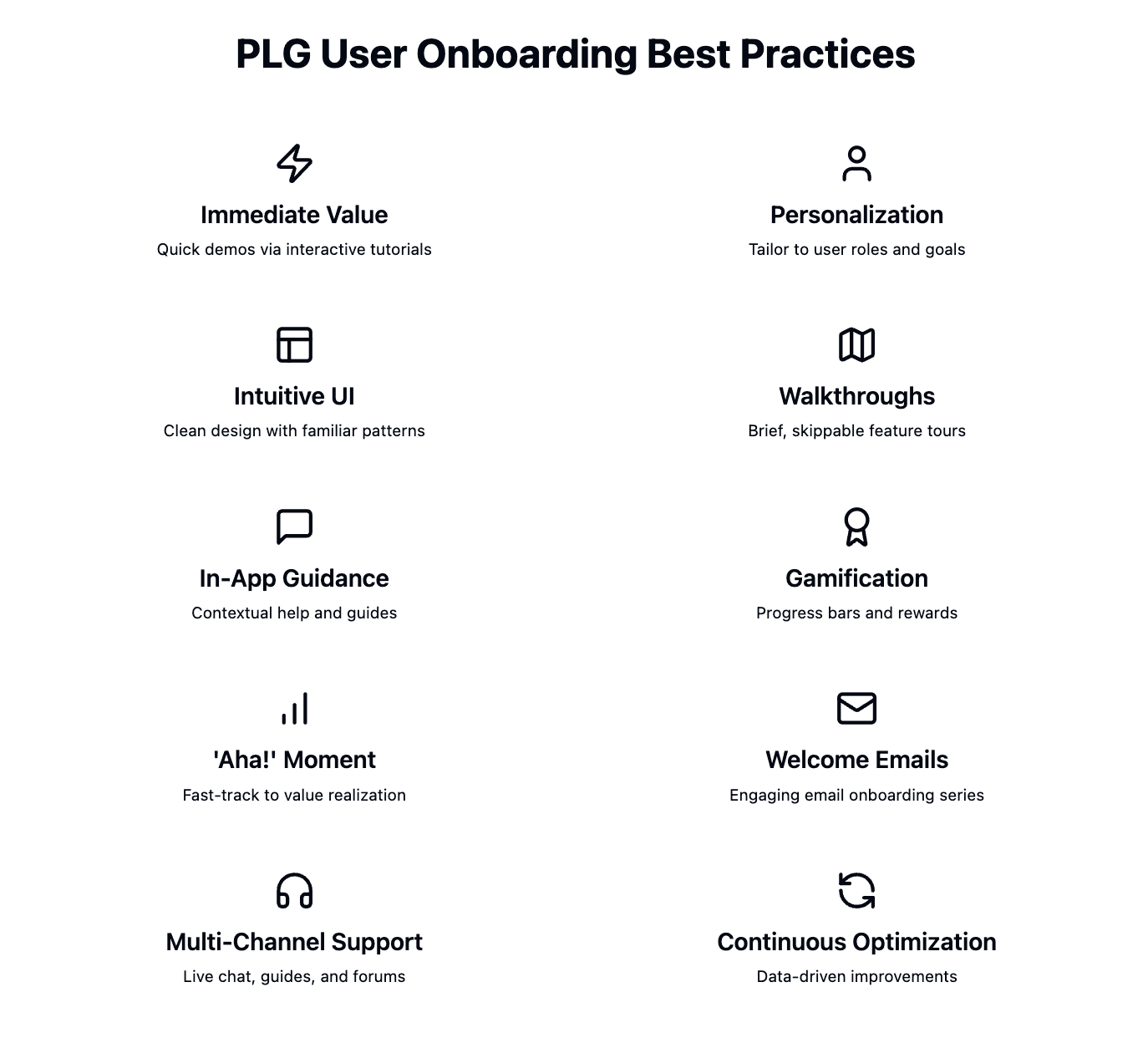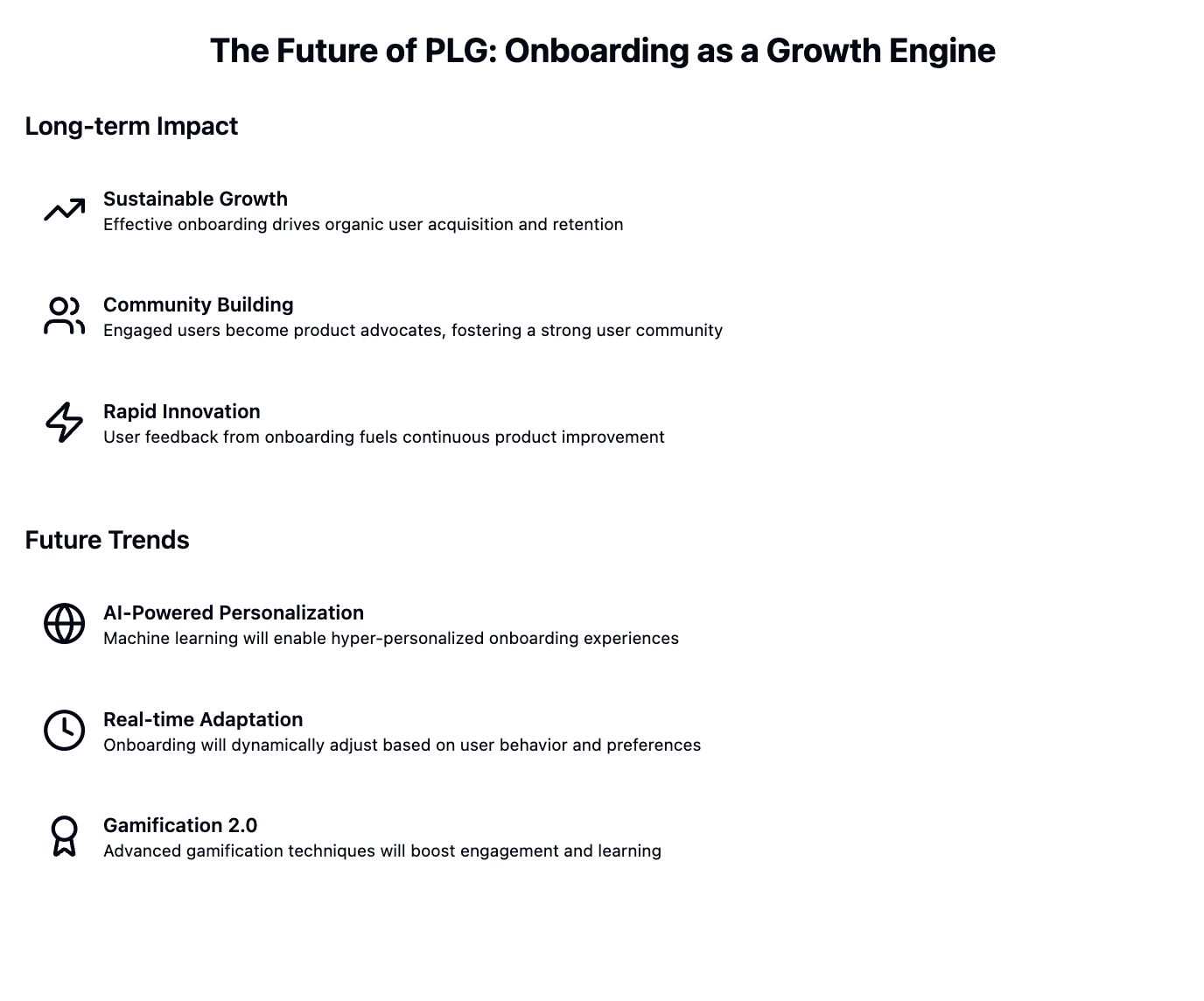
User Onboarding 15 Best Practices for PLG SaaS

par
Wiktoria Slowikowska
9 oct. 2024
Identifiez et convertissez vos utilisateurs les plus importants
Créer un compte
Introduction
Product-Led Growth (PLG) has emerged as a powerful strategy for scaling businesses. At the heart of PLG lies a crucial element: user onboarding. The way you introduce new users to your product can make or break their experience, ultimately determining whether they become loyal customers or bounce away.
This article delves into the best practices for user onboarding in PLG products, offering insights and strategies to help you create an onboarding experience that not only retains users but turns them into advocates for your product.
Understanding PLG and Its Importance in User Onboarding

Before we dive into best practices, let's briefly explore what PLG means and why it's particularly relevant to user onboarding.
Product-Led Growth is a business strategy that relies on the product itself as the primary driver of customer acquisition, conversion, and expansion. In a PLG model, the product serves as the main vehicle for marketing, sales, and customer success. This approach puts immense emphasis on creating a product that users can quickly understand, derive value from, and ultimately champion to others.
In the context of PLG, user onboarding becomes even more critical. It's not just about teaching users how to use your product; it's about demonstrating value rapidly and creating an emotional connection that turns users into long-term customers and advocates.
Best Practices for PLG User Onboarding

1. Streamline the Sign-Up Process
The journey begins before users even start using your product. A frictionless sign-up process sets the tone for the entire onboarding experience.
Minimize Required Fields: Ask for only the essential information needed to get started. You can always collect more data later.
Offer Social Sign-Ins: Allow users to sign up using their Google, Facebook, or other social media accounts for quicker access.
Implement Progressive Profiling: Gather additional information gradually as users engage with the product, rather than bombarding them upfront.
2. Provide Immediate Value
PLG products thrive on delivering value quickly. Your onboarding should reflect this principle.
Show, Don't Tell: Instead of lengthy explanations, demonstrate your product's value through interactive tutorials or guided tasks.
Personalize the Experience: Use the information you have about the user to tailor the onboarding process to their specific needs or role.
Implement Quick Wins: Design the first few interactions to give users a sense of accomplishment and showcase the product's potential.
3. Create an Intuitive User Interface
A clean, intuitive interface reduces cognitive load and allows users to focus on learning and deriving value from your product.
Use Familiar Design Patterns: Leverage common UI elements that users are already familiar with to reduce the learning curve.
Implement Progressive Disclosure: Introduce features and complexity gradually to avoid overwhelming new users.
Provide Clear Navigation: Ensure that users always know where they are in the product and how to get to where they want to go.
4. Implement Interactive Walkthroughs
Guided tours can significantly enhance the onboarding experience by providing context and direction.
Keep It Brief: Focus on the most critical features that deliver core value. You can introduce advanced features later.
Make It Skippable: Allow users who prefer to explore on their own to bypass the walkthrough easily.
Use Tooltips and Hotspots: Highlight key features with unobtrusive tooltips that users can engage with at their own pace.
5. Leverage In-App Guidance
Contextual help within the app can assist users without disrupting their workflow.
Implement a Help Widget: Provide easy access to documentation, FAQs, and support channels directly within the app.
Use Contextual Hints: Offer tips and explanations that are relevant to the specific task or page the user is on.
Create Interactive Guides: Develop step-by-step guides for common tasks that users can follow along with in real-time.
6. Personalize the Onboarding Experience
One size doesn't fit all in PLG onboarding. Tailor the experience to individual users for maximum impact.
Segment Users: Create different onboarding paths based on user roles, goals, or experience levels.
Use Data to Customize: Leverage user data to provide relevant examples, suggestions, and next steps.
Allow for Customization: Let users choose which features or tutorials they want to explore first.
7. Gamify the Onboarding Process
Gamification can make learning your product more engaging and memorable.
Implement Progress Bars: Show users how far they've come in the onboarding process to encourage completion.
Offer Rewards: Provide badges, points, or other virtual rewards for completing onboarding tasks or reaching milestones.
Create Challenges: Design fun, achievable challenges that teach users how to use key features effectively.
8. Focus on the "Aha!" Moment
Identify your product's "Aha!" moment—the point where users truly grasp its value—and build your onboarding around reaching this moment as quickly as possible.
Analyze User Behavior: Use data to understand what actions or features correlate with long-term user retention.
Streamline the Path: Remove any unnecessary steps between sign-up and the "Aha!" moment.
Highlight Key Features: Ensure that the features most likely to create the "Aha!" moment are front and center in your onboarding.
9. Encourage Action Through Microcopy
Well-crafted microcopy can guide users, explain features, and encourage engagement throughout the onboarding process.
Use Clear, Concise Language: Avoid jargon and explain things in simple terms that anyone can understand.
Inject Personality: Align your copy with your brand voice to create a more engaging experience.
Provide Context: Use microcopy to explain why certain actions are important or how they benefit the user.
10. Implement a Welcome Email Series
Extend the onboarding experience beyond the app with a series of well-timed, valuable emails.
Send a Warm Welcome: Immediately after sign-up, send a friendly email with next steps and key resources.
Provide Value-Added Content: Share tips, use cases, or customer success stories to inspire and educate.
Encourage Engagement: Use emails to bring users back to key features they haven't explored yet.
11. Offer Multi-Channel Support
Be available to assist users through various channels during the onboarding process.
Implement Live Chat: Offer real-time support for users who need immediate assistance.
Create a Knowledge Base: Develop a comprehensive, searchable repository of help articles and tutorials.
Leverage Community Forums: Foster a space where users can help each other and share best practices.
12. Continuously Optimize Based on Data
User onboarding is not a "set it and forget it" process. Continuously improve based on user feedback and behavior.
Track Key Metrics: Monitor completion rates, time-to-value, and feature adoption to identify areas for improvement.
Conduct User Surveys: Regularly ask for feedback from both new and established users.
A/B Test Different Approaches: Experiment with different onboarding flows, copy, and features to see what resonates best with your audience.
13. Don't Overwhelm with Features
In the excitement of showcasing your product, it's easy to overwhelm new users with too many features too quickly.
Focus on Core Value: Prioritize introducing features that directly relate to your product's main value proposition.
Implement a "Learn More" Approach: For secondary features, provide options for users to explore further if they're interested.
Use Progressive Feature Exposure: Introduce advanced features over time as users become more comfortable with the basics.
14. Create a Sense of Progress and Achievement
Users are more likely to complete onboarding and engage with the product if they feel a sense of progress and accomplishment.
Design Milestone Celebrations: Congratulate users when they complete important steps or achieve significant goals.
Implement a Checklist: Provide a visual checklist of onboarding tasks to give users a clear path and sense of progress.
Send Achievement Notifications: Use in-app notifications or emails to recognize user achievements and encourage further engagement.
15. Optimize for Mobile
With an increasing number of users accessing products on mobile devices, ensuring a smooth mobile onboarding experience is crucial.
Design for Small Screens: Ensure that all onboarding elements are easily readable and interactive on mobile devices.
Minimize Text Input: Use dropdown menus, toggles, and other mobile-friendly input methods where possible.
Enable Cross-Device Continuity: Allow users to seamlessly continue their onboarding process across different devices.
Conclusion

Effective user onboarding is a critical component of any successful PLG strategy. By implementing these best practices, you can create an onboarding experience that not only introduces users to your product but also demonstrates its value, encourages engagement, and sets the stage for long-term retention and growth.
Remember, onboarding is an ongoing process of optimization and improvement. Continuously gather feedback, analyze user behavior, and refine your approach to ensure that your onboarding evolves alongside your product and user needs.
By focusing on delivering immediate value, personalizing the experience, and guiding users to their "Aha!" moment, you can transform your onboarding from a necessary step into a powerful driver of product adoption and business growth. In the world of PLG, a great onboarding experience isn't just nice to have—it's essential for success.




